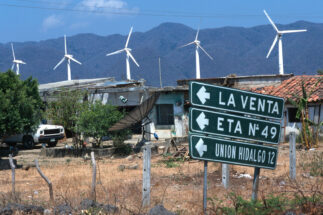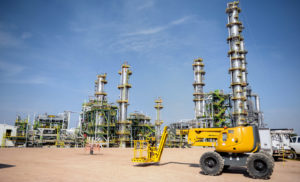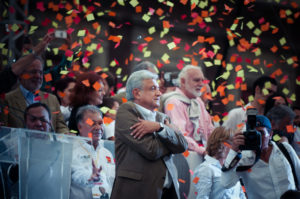Earlier this year, Mexico’s National Center of Energy Control (CENACE) issued a controversial directive limiting the amount of renewable energy that could be generated in the country.
The order suspended licences for renewable energy plants set to begin operational testing after May 3. Two weeks later, the Energy Secretariat (SENER) issued another policy blocking investment in clean energy. The moves are the latest in a series of policies that prioritise Mexico’s national energy company, CFE.
Now, investors, energy companies and consumer protection groups are pushing back.
Greenpeace Mexico, along with the Mexican Center for Environmental Law (CEMDA), achieved a temporary suspension of the CENACE agreement in mid-May. In early July, the Supreme Court suspended SENER’s May 15 agreement following two complaints: one on behalf of the Federal Commission for Economic Competition (COFECE); the other on behalf of the state of Tamaulipas.
And in August, a federal judge ordered the definitive suspension of both agreements, which will now be examined in a higher court, a process that could take months.
As a result of these suspensions, neither the CENACE nor SENER directives remain in effect. CENACE is not permitted to limit the quantities of clean energy generation, nor block operational testing of clean energy plants, as per its directive, nor is the SENER able to block further investment in the sector.
The policy comes as energy use in the country has decreased by 10% as a result of Covid-19 prevention measures. The agreement lists as justification several incidents of failures in the energy system, arguing that the measures will keep the electricity supply as safe and reliable as possible, in the context of the current health emergency.
The ultimate end of those percentages is to have a better air quality, which will lead to a better quality of life and health
But clean energy advocates say the reliability of renewable energy is a non-issue.
Paul Sanchez is the director of Ombudsman Energía México, an NGO dedicated to protecting rights in the energy sector. He says the role of CENACE is to regulate the energy supply in real time: “If there is really a need to do that, then CENACE does that.”
Concerns that a surplus of energy could cause the system to fail, Sanchez says, suggest a lack of trust in the operator of the energy system.
Clean energy sector representatives say the policy uses the pandemic as an excuse to stunt the growth of the industry.
“It’s not an isolated action,” says Luis Romero, a renewable energy specialist formerly of Ren Mx, a World Wildlife Fund initiative dedicated to expanding demand for renewable energy in Mexico. “It doesn’t occur in a vacuum. It joins a series of actions from the current administration to strengthen CFE. The administration is trying to do energy policy through state institutions, and not through the institutions created for that purpose.”
35%
the prescribed share of renewables in Mexico's energy mix by 2024
Mexico’s 2014 Energy Reform package dislodged the monopoly that the Mexican state had previously held over energy production, distribution and commercialisation. It opened the gates for private investment in the energy sector, including in renewables. The 2015 Energy Transition Law set policies in place for the country’s transition to clean energy. It prescribes 35% clean energy use by Mexican industry by 2024.
Despite these commitments, President Andres Manuel Lopez Obrador is determined to reinvigorate Pemex, the state-owned petroleum company, and increase the country’s oil production. Mexican’s energy secretary, Rocio Nahle, recently came under fire as the only representative to refuse to sign an agreement by the Organisation of Petroleum Exporting Countries (OPEC) to reduce global oil production by 10 million barrels a day.
Sanchez says the recent directives fall into a pattern of policies that stigmatise renewable energies: “The logic isn’t one of reliability, but one of protectionism of the state monopoly…It rests on the idea that renewable energies are a problem more than a solution, and as such, they need to be controlled more aggressively.”
The agreement also risks Mexico’s fulfilment of international environmental treaties, including the Paris Agreement.
“We have commitments for a certain percentage of clean generation, and we aren’t going to reach those percentages. We’re under a lot of pressure, and these policies are leaving us with our hands tied,” says Romero. “The ultimate end of those percentages is to have a better air quality, which will lead to a better quality of life and health.”
Some advocates, however, argue that the Mexican state needs more than just clean energy to confront its environmental issues and the development of renewable energy plants has brought its own human rights concerns.
In southern Mexico, companies developing wind farms have been accused of violating the right of rural and indigenous communities to a free, prior and informed consultation on projects that affect their land.
In response to the directives, Onergia, an NGO based in Puebla, central Mexico, wrote in a communiqué: “It’s not enough for energy to be ‘green,’ as its model requires great extensions of territory with millions of panels or wind turbines that aren’t ecological, as they displace communities and end local economies of food production and water preservation.”
The prioritisation of large energy corporations, whether clean or dirty, Onergia argues, doesn’t address the issues necessary for a just transition to clean energy.
“When we talk about a just transition, we don’t talk about a technological question, like wind farms or solar panels,” says Aguilar. “The goal should be to generate well-being.”





![The expedition to climb Lalana was an adventure that none of the people on it would forget; Sudipta (right) and Kamala [image by: Sudipta Sengupta]](https://dialogue.earth/content/uploads/2020/09/Photo-08-300x216.jpg)


